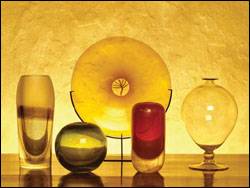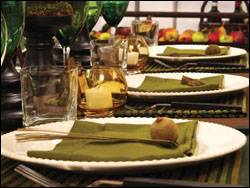Understanding Style
| One of the most important characteristics of a good prop stylist is a keen understanding of style. The stylist can choose an array of props to evoke many themes such as modern, contemporary, traditional, ethnic, futuristic, or surreal. They can also use props to stimulate emotionsserious, dreamy, romantic, or playful. Once the style of a picture is decided, work begins on design. Each shot has a key element, which is why no two shots are ever the same. The key elements are affected by how the shot is going to be used in the layoutvertically or horizontally, how the camera will "see" the set, and how the food will be placed on the dishes. To achieve the desired design, the prop stylist needs to understand how the elements of color, size, texture, and patterns in the food are affected by the dishware, silverware, flowers, glasses, plates, and backgrounds. For example, in creating a vertical shot where the key element is in the center, the prop stylist will create the set from the center out. The stylist will place the featured dish in the center, and then fill in the shot by placing smaller or lower items in front of the dish and taller items in the backgroundnever using items that will distract from the featured dish. The prop stylist builds the set around the featured item and helps create the final vision. In this way, prop styling is a little like baking a cake. At first, the cake is simple, but then it is decorated delicately, always keeping in mind balance, color, texture, and overall design. ColorColor is of utmost importance when styling a shot. The color of the food, or the color scheme of a setting, will determine what props can or cannot be used. Many prop stylists create their own personal notebooks, which contain Pantone sheets, fabric swatches, and paint tabs, to help them in the process of selecting complementary props. These can be especially useful in larger photo shoots. Tip When speaking to the client, it is very important to listen for specific words or phrases that describe a color or moodfor example, "earth tones," "vibrant colors," "rich tones," "pastels," and so on. This is especially helpful when clients are unable to name a specific color. Tip If gels are used to change the color of the light in a scene, the color of the props also will be affected. The prop stylist and the photographer should work together when it comes to the selection of gels. Size and ProportionCommon sense is not always the order of the day when deciding what size plate should be used with that piece of fish you are shooting. From the photographer's perspective and angle of shooting, a 10-inch dinner plate could overwhelm the photograph; a six-inch salad plate may be a better choice. It is up to the photographer and client to decide at what lens perspective and angle the camera is "seeing" the set. Adjusting the size and front-to-back position of props is another technique that can affect the apparent depth of a photograph. FoodNow for the key ingredient: food. Depending on the client's vision for the shot, food can be viewed as provocative, fun, or simple, yet it must always look appetizing and delicious. Placing the props so they maintain harmony and balance with the food is critical. |


